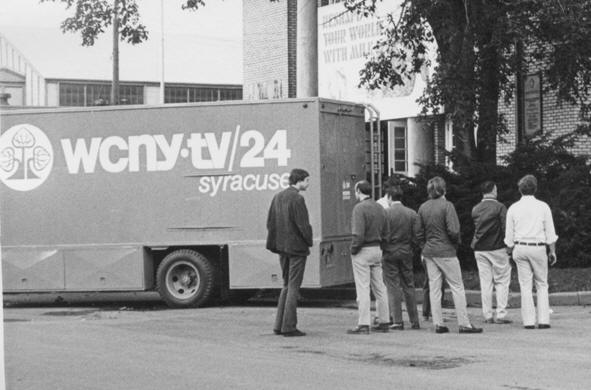
GOING PLACES

The addition of a mobile unit at WCNY opened up new possibilities and new challenges for Channel 24 programming. Designed and constructed under the supervision of chief engineer Paul Barron, the remote truck carried three black-and-white G.E. cameras, a two-inch quad videotape recorder, the necessary monitors and switcher for the director, and room for the audio mixer, engineers, and support equipment. Occasionally WCNY would partner with other stations for special remote coverage: "One of our larger remotes was a track meet in Cornell where we had cooperation with the Rochester station, WXXI, so we had two trucks and nine cameras,” says Bill Upwood.
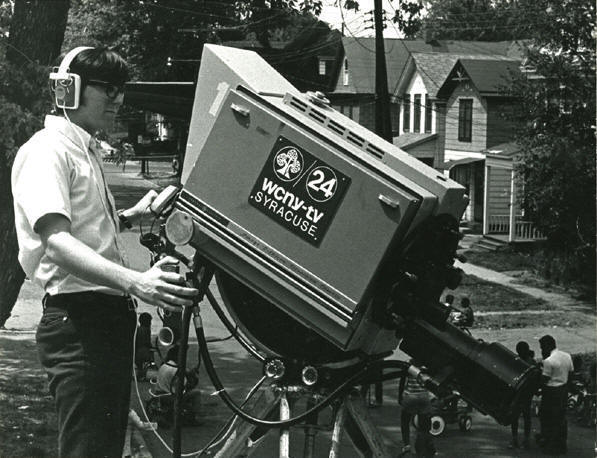
CAMERA OPERATOR MIKE CLARK ATOP THE CHANNEL 24 MOBILE UNIT
The mobile unit also had space on the roof for a camera platform providing valuable high-angle shots during sporting events, parades, or festivals. To provide viewers with more interesting angles and setups, cameras were often placed upon golf carts, raised platforms, roofs, and cherry pickers.
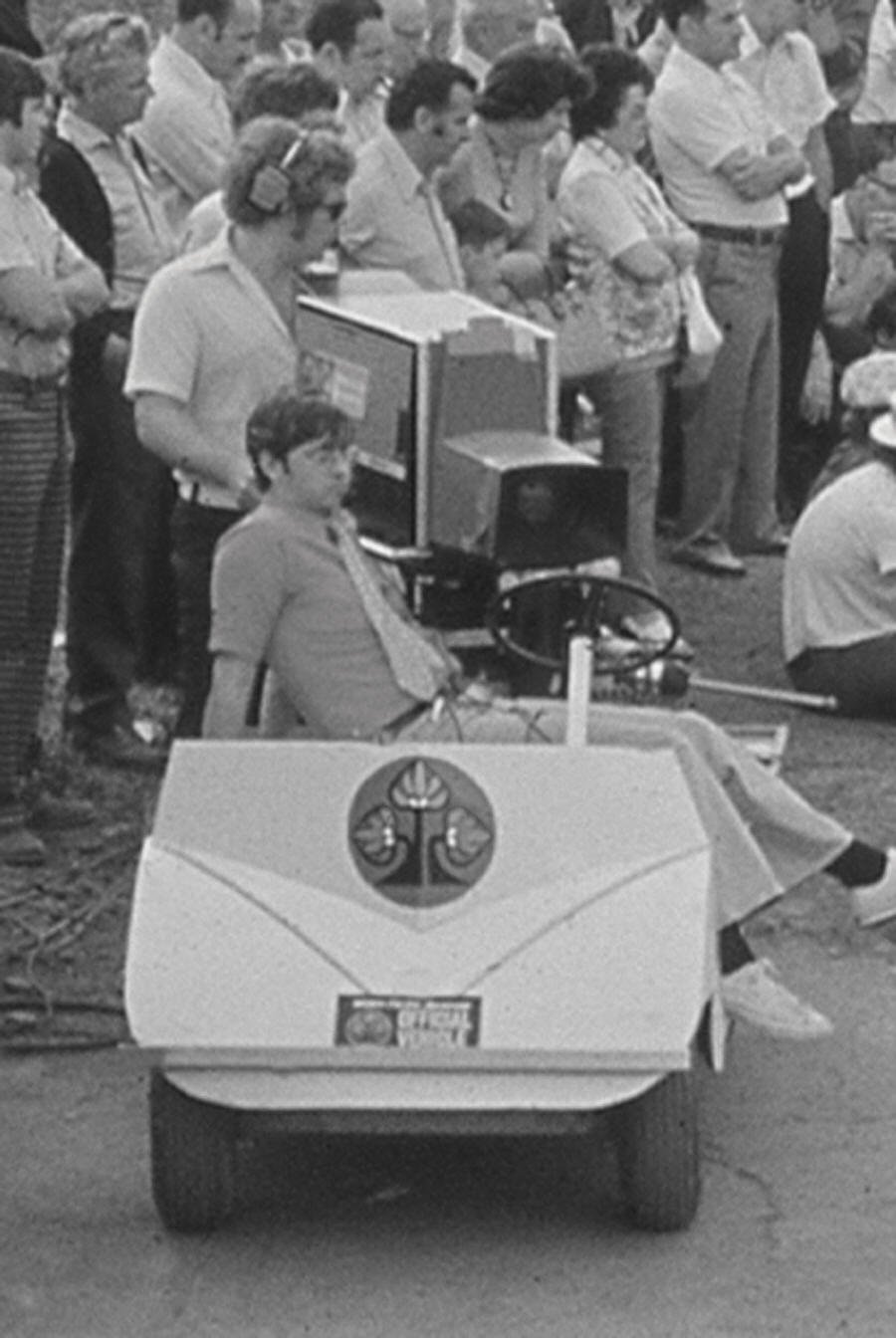 |
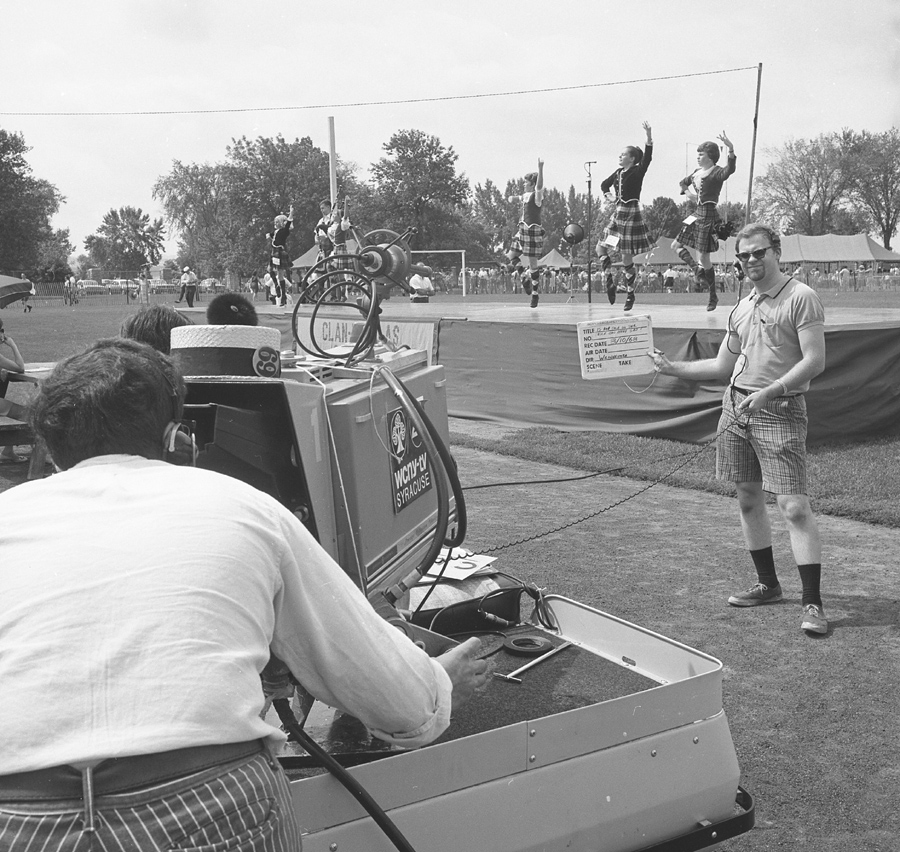 |
Left - A Bocce tournament in 1974 Right - Camera operator Ron Friedman lines up a shot at The Scottish Games in 1968
The station's young production staff was always pushing the envelope to deliver bold, dynamic shots to the home viewer. For the Scottish Games remote in 1968, camera operator Ron Friedman's effort to achieve a spectacular shot almost got him impaled. "I kept urging the driver of the golf cart with the camera to get closer and closer to the caber* toss," recalls Friedman. "I wanted to be on top of the action for a dramatic, wide-angle close-up as a 20-foot-long, 125 pound caber was tossed. I urged the 'tosser' to aim right toward the camera, not realizing how far the caber would go or how good his aim would be. Looking into the viewfinder as the caber came crashing down barely missing the lens, I thought, 'what a great shot!' Later, when the wisdom of my decision to move closer and 'direct' the tosser was questioned, I replied with the righteous indignation of the young and invincible, 'but it was a great shot!'"
*A caber is young tree trunk used for tossing as a trial of strength in a Scottish sport
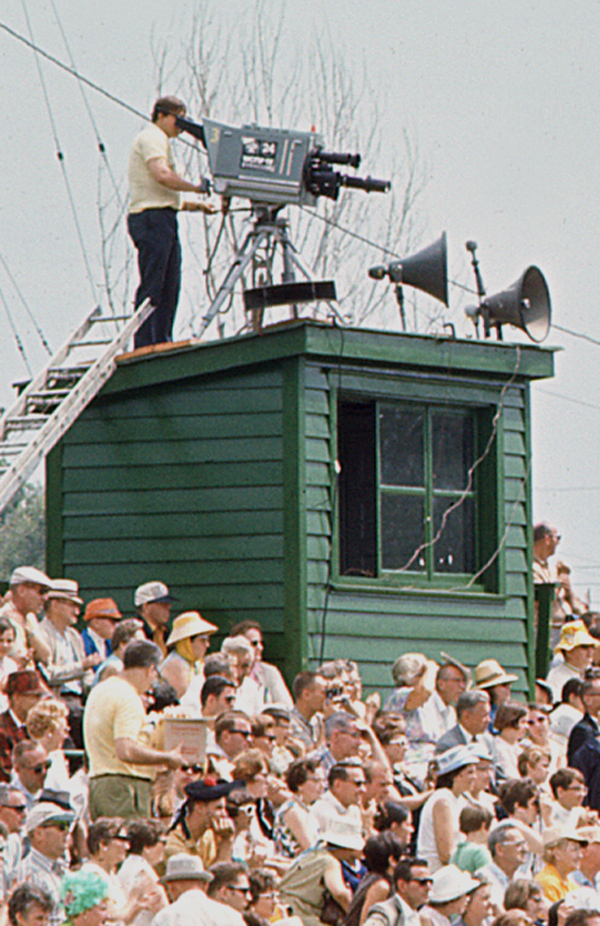 |
Negotiating hot summer days and
freezing winter temperatures was part and parcel of a camera
operator's job. Equally challenging was working around crowds
of spectators who didn't take kindly to the camera blocking their
view of sports activities.
Left - A WCNY camera sporting telephoto lenses for long-distance coverage. |
|
High school sports, local civic events, and coverage of the Syracuse Symphony and the Syracuse Blazers hockey became regular treats for Channel 24 viewers. “We had to plan our camera positions for the Syracuse Symphony with great care,” recalls Production Supervisor Bill Upwood. “We built a foamcore and cardboard model of the orchestra layout and used it to pre-plan our camera placement...and it worked out very well." Right - Dick Calagiovanni, Dick Cowden, and Bill Upwood plan coverage of the Syracuse Symphony |
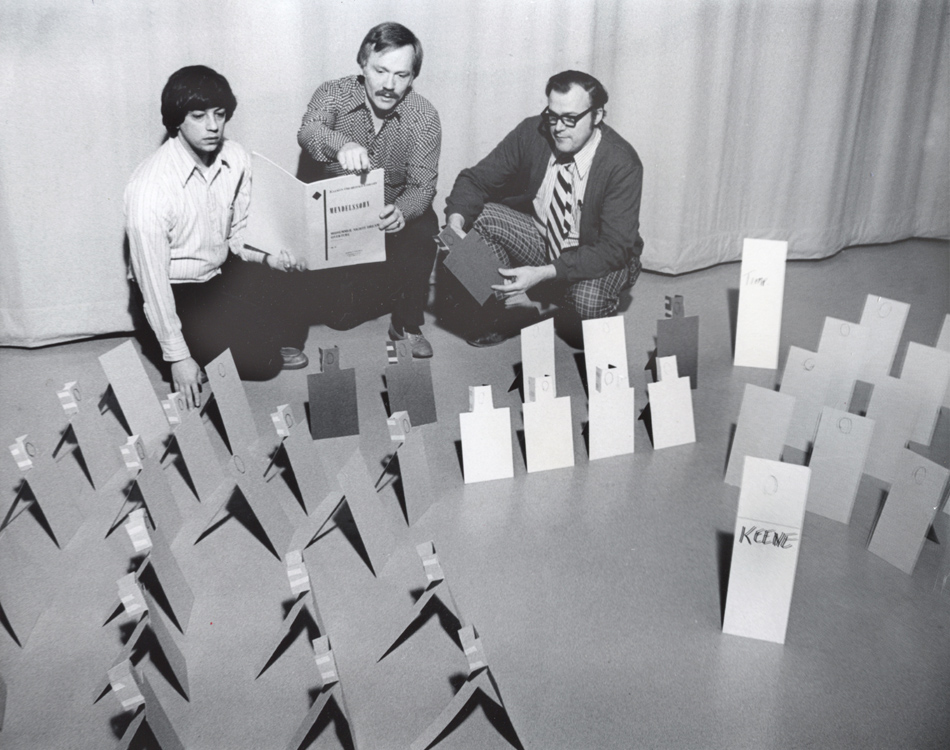 |
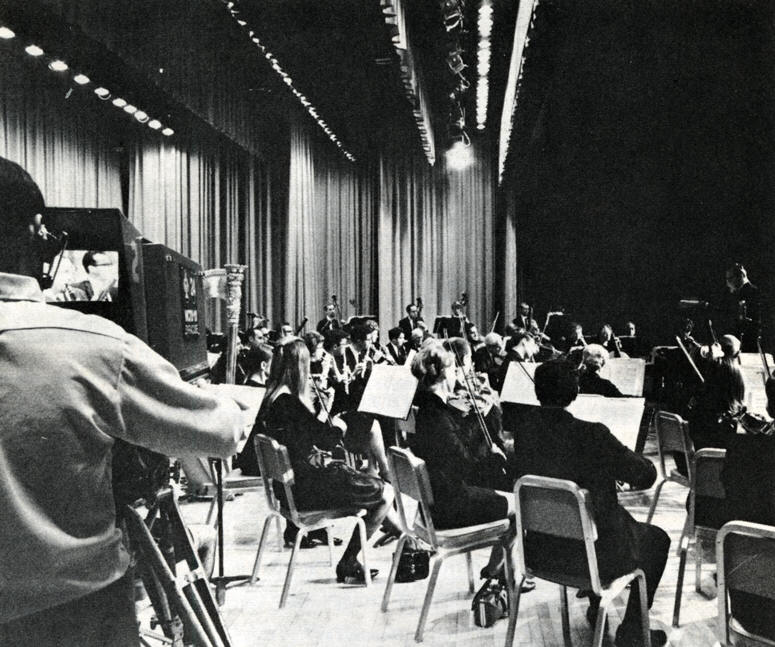 |
The advance planning Upwood and his
associates put into placing cameras at the Syracuse Symphony
resulted not only in viewers having a front row seat at the
concert...they were amongst the musicians thanks to a
mobile camera that roamed the stage perimeter. The camera
also covered the orchestra leader as seen from the musicians
point-of-view!
Left - A strategically placed camera gives viewers intimate shots of the musicians |
Even the snows of Syracuse wouldn’t stop Channel 24’s live coverage of the Syracuse Blazers. “We were lucky that our mobile unit would fit into a parking space directly under the ice at the old Syracuse War Memorial," Upwood states. "It was an easy cable run up to the ice while outside there were blizzard conditions.” The mobile unit carried its own portable microwave that beamed a signal to a repeater on the roof of the MONY building in downtown Syracuse, which forwarded the signal to the station. At the time, Channel 24 was the only station in town with this live remote capability.
MAGICAL MYSTERY TOUR
Perhaps the most unique and high-profile remote from the station's early years was the appearance of former Beatle John Lennon and his wife Yoko Ono at the Everson museum. The spotlight was on Ono’s unusual exhibit of eclectic environments titled This is Not Here.
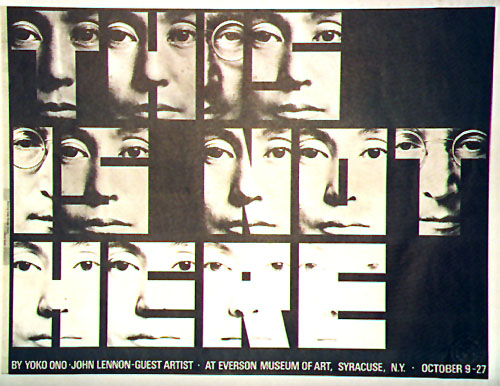
POSTER FROM YOKO ONO's EXHIBIT AT THE EVERSON MUSEUM
Covering the Ono exhibit was a last-minute decision complicated by management's attitude that black-and-white video wouldn't do justice to the subject. Luckily, a color mobile unit was available from Massachusetts and secured for the production. With technical facilities in place the main issue facing the Channel 24 staff was the lack of a conceptual way to cover Ono’s show. “Everything was very last-minute,” recalls Dick Calagiovanni, who served as the remote's floor manager. “The Ono exhibit was not artwork or sculpture…it was high-concept life experiences. In one gallery visitors had to wear gas masks! One of the displays had candy dispensers that shot compressed air. Another space had living room furniture painted white. All of the pieces...the chairs...sofa...etc, were cut in half. I'm sure there was some kind of message there.”
Camera
operator Russ Tarby also has vivid memories:
"One
of the This Is Not Here 'exhibits' was empty clay planters with the
message: ‘Imagine the flowers.’ In an exhibit space called ‘The Water
Room,’ a bearded man disrobed and took a bath. Another display was a
Volkswagen Beetle filled with H2O."
With no firm visual strategy in hand the WCNY crew arrived at the Everson
and began the setup.
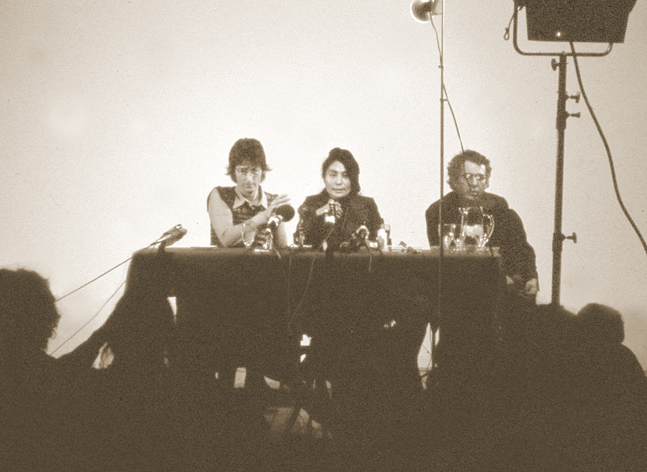
JOHN LENNON AND YOKO ONO AT A PRESS CONFERENCE FOR "THIS IS NOT HERE"
AT RIGHT IS THE EVERSON'S CURATOR, JAMES HARIATHAS
For the young production staff the exhibit took second place over their excitement of working with John Lennon. “I didn’t even know if I was going to meet Lennon," admits Calagiovanni. "I was a big Beatle’s fan, like everyone else. I played drums in teenage rock bands and couldn’t believe we’d be working with John Lennon, one of music’s biggest stars. And then I got to meet Lennon face-to-face! We ended up waiting a few minutes for Yoko to appear and I got to talk with John about the museum and the area. He thought the museum was cool and we spoke about the interview process. During the taping, Phil Spector, the famous and notorious music producer, stopped by. He and John were working on a project at the time. I could kick myself now because I didn't think of bringing anything for John to autograph.”
The WCNY crew did their best to cover the exhibit but producer Ted Weinheimer and WCNY's general manager Richard Thomas were uncertain how the final product would come together in editing. “We had no idea what to do with the show after it was on tape,” explains Calagiovanni. “We solved the issue by using John Lennon’s new album Imagine as an underscore. The finished program was more like a music video showing the displays and people walking through the galleries mixed with interviews of Lennon and Ono. We heard later that John and Yoko liked it.”